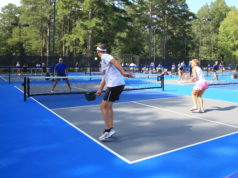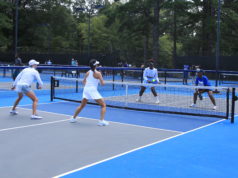By John Lowell, Mixed Doubles Vice President
By the time you read this, I will have completed my final season as the Mixed Doubles Vice President. It has been my honor to serve the more than 20,000 ALTA members who have played Mixed Doubles each of those seasons. I’m devoting my final article to the most misunderstood process in ALTA — leveling of teams, as well as the effect that asking for a Request for Review can have on this process.
Leveling is one of the most difficult tasks that an ALTA volunteer faces. In the Mixed Doubles League, we have between 900 and 1,000 teams, and between 160 and 210 of them have done a Request for Review (RFR) during my tenure. Our goal, of course, is to put each team at its appropriate level to ensure fair and equitable competition. That’s not always easy.
Each division has either eight teams resulting in seven weeks of matches or seven teams resulting in six matches and a bye. That means that we sometimes must move teams to a different level to make scheduling work. Sometimes, we do that based on RFR, and sometimes we do it based simply on ALTA’s needs.
Let’s talk about RFRs. When a captain or other ALTA member submits a roster for a season, they have the option of requesting that we take a closer look at their team during leveling. They check one or more boxes and then can write a narrative explaining why their team should be placed at the requested level. With respect to the Mixed Doubles League, I can tell you that for every team that requested a level change through an RFR over the last four seasons, I looked in detail at the recent play history of every player that the team lost and gained. In addition, the appropriate overall coordinator did a similar analysis for each team within their purview. When the RFR was honest, I knew it, and when the RFR provided alternative facts, I knew that as well. Remember, this is a Request for Review, not a demand for a level to which we must adhere.
What exactly happens when you do an RFR? We evaluate your team based on the roster you submitted. So, if you tell us you lost players and you later try to add back the players you lost, the system might not let you. Is that fair? Of course, it is. We leveled the team without your line 1 pair, for example, so when you want to add them back after you’ve been granted your lower level, we’re not going to allow that.
In fact, when you try to add a player to your roster after schedules have come out, as most of you know, the system looks first at the ranking of the player compared to the level at which your team has been placed. If you are a returning team and the player was on your roster the season before, the system will usually let you do that. A major exception occurs when your team has done an RFR. In cases where we did partially or fully grant your request to be leveled lower, the system automatically disqualifies your attempt to add that former team member as an “automatic” add. It necessitates a more complex process, and you might not be able to add that particular player.
Leveling is difficult. ALTA volunteers try extremely hard to get it right. That said, we never will. We pay extreme attention to RFRs. Evaluating them always requires a lot of judgment. There is no formula. In fact, the mere presence of an RFR means we are going outside the formula.
Frivolous RFRs do not help you or your team. When you put information in there that is simply not true, I look at everything you’ve written with a jaundiced eye. My strong suspicion is that other volunteers do as well.
When we make a big error in leveling by placing your team too high, it bothers us as much as it bothers you. What we tend to do is give you special consideration the next season. The ALTA leveling process is self-correcting, although it might take a season, or even two or three, to get it right with respect to your team.
Yes, it has been my honor; it has been my pleasure as well. I’ll see you around the courts but not wearing that VP Mixed Doubles name badge.




